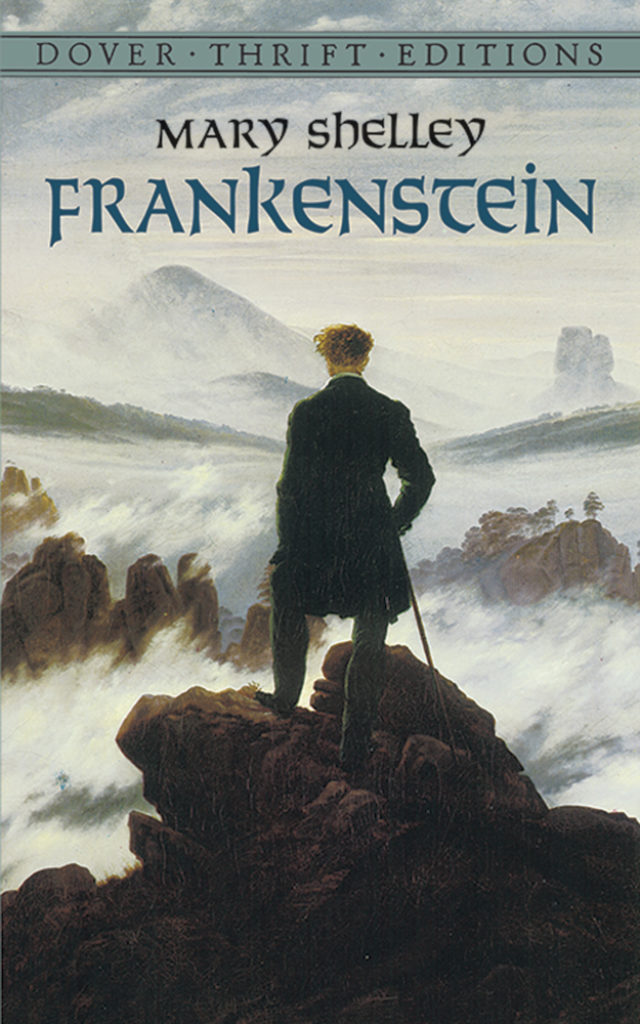Frankenstein by Mary Shelley has been reviewed by Focus on the Family’s marriage and parenting magazine.

Frankenstein by Mary Shelley has been reviewed by Focus on the Family’s marriage and parenting magazine.
In the 18th century, a sea captain named Walton writes to his sister from his North Pole expedition. He tells her he’s rescued a scientist named Victor Frankenstein, and he shares the man’s strange and horrific tale:
Frankenstein lived with his close-knit family in Europe. His parents adopted an orphaned girl named Elizabeth, and they hoped she and Victor would marry someday. Victor and Elizabeth both looked forward to this marriage.
As a young man, Victor leaves home and studies science. He begins to experiment, hoping to reanimate dead bodies. He pieces together a creature and manages to bring it to life. When it begins to move, he is appalled by its hideous form and distraught by what he’s created. Frankenstein flees his laboratory. He later returns to find the creature is gone. The incident causes Victor to fall into a lengthy illness. His friend Henry nurses him back to health.
Months later, Victor returns to his family’s home in Geneva. He sees his creature climbing a mountain nearby. Then he learns his brother, William, has recently been murdered. Justine, William’s caretaker and a family friend, is accused of the crime. Victor knows his creature is to blame, but he is unable to prove Justine’s innocence or prevent her hanging. The grieving Victor runs away to the mountains. His creature finds him there and gives Victor his account of entering the living world:
The creature explains that after leaving Frankenstein’s house he quickly discovered that humans are terrified of him. He hid out in the woods but began to watch a family in a nearby cottage. He learned how to speak and act over the months he spent observing them. Finally, he decided he wanted to befriend them. He believed he might succeed if he could first introduce himself to the blind father alone.
The father was amiable as the creature spoke of his desire for friendship. But when the rest of the family returned to see the creature in their home, they screamed in terror. The creature fled. He later burned down the house in frustration when he realized humans would never accept him. He began to hunt for information about his creator. His first act of revenge against Frankenstein was to kill William.
The creature demands that Victor create a woman like him so he won’t be alone in the world. He promises to vanish forever if Victor does this. Victor reluctantly agrees and goes to do his work on a remote island in Scotland. He knows the creature is watching him. He has great difficulty making himself start the project, especially as he imagines what might happen if the creatures produce offspring. He finally destroys the female, and the enraged monster vows he will be with Victor on his wedding night.
Victor leaves for Ireland and is accused of murder upon arrival. He learns the deceased is his dear friend Henry. Victor is eventually acquitted, but the incident devastates him. He returns to Geneva to marry Elizabeth, all the while fearing the creature’s threat. Frankenstein spends the wedding night anxiously watching for the monster, only to have the creature kill Elizabeth in the next room. Devastated by Elizabeth’s death, Victor’s father dies a few days later. Victor has lost everyone he loved, and he vows to have revenge. He pursues the monster as far as the North Pole, but then he collapses. That’s when Walton finds him.
Narration about Captain Walton resumes. With the ailing Victor aboard and the ice becoming too difficult to navigate, the captain decides to turn the ship around. Victor dies, and the creature comes aboard to mourn him. Walton discovers the creature, and the monster laments that his creator’s death hasn’t brought him the peace he’d expected. He vows to kill himself and floats away on a raft of ice.
The monster refers to himself as Frankenstein’s “Adam,” since the scientist was his creator. He laments the fact that Frankenstein considers him more like Satan than a son.
Frankenstein calls his mother’s death a bad omen.
Frankenstein creates a monster but cannot tolerate it when it comes to life. He agonizes about how to satiate the creature’s need for love without creating a race of monsters that would haunt future generations. Victor’s parents take in the orphaned Elizabeth and love her as their own.
The Lord’s name is used in vain a few times.
Though not described in graphic detail, Frankenstein tears apart his female creation. Justine was hanged, and a cottage was burned down.
None
Get free discussion questions for this book and others, at FocusOnTheFamily.com/discuss-books.
Historical context: Mary Shelley wrote Frankenstein in 1818 and revised it in 1831. The 1831 text is the version most commonly found in modern reprints of the book, including this one reviewed by Focus on the Family.
You can request a review of a title you can’t find at [email protected].
Book reviews cover the content, themes and worldviews of fiction books, not their literary merit, and equip parents to decide whether a book is appropriate for their children. The inclusion of a book’s review does not constitute an endorsement by Focus on the Family.